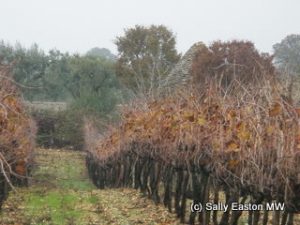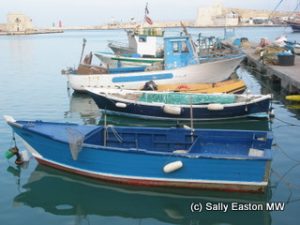Nero di troia

Wintry Puglian vineyard
The origins of the increasingly impressive nero di troia remain uncertain, though an abiding story is that it is named after a village near Foggia in the north of Puglia. Indeed the variety is mostly found in the north of this region, while other mainstay grapes primitivo and negroamaro are found in the centre and south of Puglia.
Castel del Monte is the main DOC of northern Puglia, in which nero di troia plays a leading role. This area accounts for a quarter of Puglia’s 5,000 hectares of the grape. Altitude is a key advantage in Castel del Monte, as Francesco Liantonio of Torrevento, whose vineyard Vigna Pedale is 500m above sea level, explained “in summer we have temperature changes between day and night of 10 to 15°C. This gives freshness to the wine.”
While much nero di troia is bottled as IGT Puglia, other DOCs in which nero di troia plays a significant role include Rosso Canosa, Rosso Barletta and Rosso di Cerignola.
Nero di troia was traditionally blended with other local varieties. Sebastiano de Corato, of Rivera said “nero di troia is a very late variety, it ripens till October, when it’s raining in Puglia. The tannins are an issue, so the fear of having wines with too much tannin [meant] it was blended with softer varieties such as montepulciano.”
It is only in the last 15 years that the variety is emerging as a flavoursome, qualitative grape variety, and one made as a single varietal wine. Enzo Scivetti, of sommelier association ONAV (Organizzazione Nazionale Assaggiatori di Vino) said “15 years ago there were only two or three labels of pure nero di troia. Now there are more than 80 different labels.”
Historically, Scivetti said “nero di troia had a constant but difficult evolution. It was extensively planted in the 19th century around Foggia, Benevento and Basilicata.” And more recently, “for decades it was considered not a very elegant grape variety. The wines were tannic and strong, and it needed years to make these wines smooth and softer.”
Scientific research into the variety, the types of planting and training revealed that production had focused on big grapes where strong tannins and herbaceous notes could develop. But, Scivetti said “by limiting the yield, grape size decreased and the herbaceous characters disappeared. The phenolic content changed, and it became a wine that could be aged.”
Barletta-based Tenuta Rasciatano employed Naples university oenology Professor Luigi Moio to work with their nero di troia. Moio had been studying aromas for many years and said “I came across nero di troia in 2001. I was struck by its aromas, especially in the back palate, which reminded me of coriander and powdered cherries.”

Trani, on the Puglian coast
Making nero di troia as a single variety can be challenging, as Moio explained “nero di troia is usually very tannic, and the anthocyanin concentration is high, so maceration can be a problem to manage. You need a more moderate temperature to keep the tannins under control, and maceration lasts only 10-12 days.”
Firstly, though, he said “grapes are picked as they ripen, little by little, not all at the same time” to ensure only ripe tannins go into the vat.
For Rivera it was in the mid 1990s, when the family started selecting for small berries that the vines “started producing fruit with good concentration” said de Corato, “the fruit balances the levels of tannins, so there was no need to blend.” Though they do use micro-oxygenation.
Oak also helps with tannin management. Moio said “a tannic wine will always be tannic, so winemakers must plan wines from nero di troia so that it becomes softer. Oak plays an important role in this, where the main role of the oak is played on the tannins, not the aromas.”
No-one is saying nero di troia is the next big thing. Indeed de Corato said “maybe nero di troia will never become a fashionable wine among regular consumers as happened with primitivo and negroamaro. It is probably more for more evolved consumers.” But not everything can be mainstream.
Tasting notes, in situ, November 2011.
On the basis of a small tasting, it’s worth the effort to get that mix of herbs, aromatic spices, graphite, plums and cherry fruit in a wine that’s not hugely full bodied.
Tenuta Rasciatano, Nero di Troia 2007, IGT Puglia
Black tea leaf, petals, and savoury tannins that are somewhat nebbiolo-like in texture. The body is smooth, soft, round, and not so firm with acid. This is elegant and very finely textured, with notes of leather and hints of biltong and cardamom sweetness and dark, dried cherries. Length is good.
Rivera, Puer Apuliae 2007, Castel del Monte DOC
Smoke, black tea and smoked spices. Some fine-grainy tannin texture, savoury, graphite, leathery. Lovely medium bodied texture, with chalky dry tannins. Elegant with aromatic herbs and a long in-palate length. Good.
Torrevento, Vigna Pedale 2008, Castel del Monte DOC
Dark dried cherries, mulled spices and black tea leaves, with a violet perfume emerging. Good primary fruit here too – black cherry, dark fresh plum. Medium body, with fresh and gentle acidity, ripe fruits, and faintly dry and fresh tannins. A sweet texture makes it wholesome.
My trip to visit and judge wine in Puglia was sponsored by the Puglia Best Wine Consortium.
Comments
7 Responses to “Nero di troia”




December 16, 2011 at 9:20 am
My impression from the Apulian Wine Identity tasting was that nero di troia was sometimes even the most interesting of the three grape varieties that the organisers had chosen to focus on, with better structure and less punch-in-your-face than some primitivos and negroamaros. But there were of course good and less good examples of all. But for me, nero di troia was the biggest positive surprise.
December 16, 2011 at 9:34 am
Hi Per, thanks for your comment.
Yes, me too. I was impressed with the structure and flavour profile of the few we tasted and judged. They’ve clearly been doing good work with it to manage those tannins. Definitely a grape variety on the up.
Not much good for you, but Waitrose had a good example at their last press tasting, also from Torrevento: Torre del Falco, Nero di Troia 2007, Puglia, Italy £7.99
March 25, 2012 at 1:46 pm
Just opened a 2007 Il Guerro 100% Nero Di Troia from Paolo Petrilli I bought from Ben at Bat and Bottle on my last trip back to UK. This is the most marevllous and impressive wine I’ve tasted for ages (and I’m in the trade). The fuit and spice profile is so complex,everything from dark plums, cinder toffee, eucalyptus, anise, etc etc, yet the fuit is not overpowering or heavy on the palate, in fact the wine is strangely refreshing, the tannins present yet elegant, the finish long, long, long. This is my first experience of nero di troia and I am eager to try more. I urge you to call Ben and try this wine. For now, gan bei. Laura x
March 26, 2012 at 10:18 am
Thanks for the tip Laura. I was certainly impressed with my first tastings of the variety last December.
May 31, 2013 at 1:15 pm
your blog is WONDERFUL. thank you!
April 21, 2014 at 1:55 pm
Waitrose have the Torrevento at a bargain £5.99, two quid off. Went great with ham, salad and soft blue cheese. Very tasty wine.loved the Biltong reference!!!
April 21, 2014 at 1:58 pm
As a footnote the taste is predominantly cherry ish. Tannins are there for sure, but tamed nicely.